Editor’s Note: We welcome in our contributor, John Ingham, again who explores how riding gravel promotes happiness despite the pain and suffering in his latest essay.
To Cosmos and Beyond – by John Ingham
The efflux of the soul is happiness, here is happiness,
I think it pervades the open air, waiting at all times,
Now it flows unto us, we are rightly charged.
— Walt Whitman, “Song of the Open Road’
So we saunter toward the Holy Land, till one day the sun
shall shine more brightly than ever he has done, shall
perchance shine into our minds and hearts, and light up our
whole lives with a great awakening light, as warm and
serene and golden as on a bankside in autumn.
— Henry David Thoreau, “Walking”
Don’t forget to ride with the pace of the land
listen to its stories as you go
remember that the great leveler is not speed
but the stars under which we will all be riding tonight
For it is through these cosmos and their dusty exit wounds
beyond the imagination of gods
from the clearest air in our lungs and within the
reddest chambers of your hearts
that we will remember to look up into this night
with curiosity, imagination and fearlessness.
—Ben Weaver, from “Day Across Minnesota”
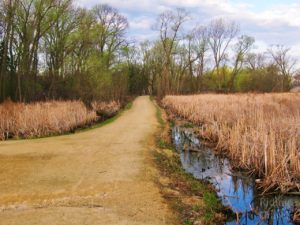
I had been riding trails west of Minneapolis for many years, but since getting into gravel riding I have been taking them for longer rides, often using gravel roads to link them together. By last summer I had my sights on Cosmos, a small town at the western end of the Luce Line. In August, I almost got there before turning around on the final stretch of bumpy mowed grass—it was slow going and late in the day, and I was tiring and a long way from home. I promised myself to try again.
It is often uncomfortable out there. It can be windy or wet or both, and often more hot or cold than just right. We are plastered with mud or soaked with sweat. Thighs burn. Butts hurt. Shoulders and forearms ache. Bodies shiver and fingers go numb. Yet, we are usually happy, sometimes unusually and mysteriously so. The Velominati say the magic happens when we accept suffering but don’t identify with it and when we “harden the fuck up.” I am sure they are right, but I am also sure there is more to it. I would like to think they would agree with me.
In this post, “cosmos” is a small prairie town with a curious name and an opportunity for pondering moments on long rides when a strange alchemy transforms pain and effort into happiness, even ecstasy. I suspected a link between this alchemy and the town’s name, but even so, what turned up surprised me. Initially dubbed Nelson Town after its first family, the settlement was established as a township and renamed Cosmos in 1870 following a suggestion by Daniel Hoyt, another early settler. Derived from the Greek kosmos, the word means “order” and “harmony.” Hoyt was “a cultured and highly educated man from New Hampshire.” Arriving in 1864, he homesteaded on the southern edge of Thompson Lake, a short distance west of the town. A “visionary and eccentric character,” Hoyt persuaded Nelson to agree to the name change in hope of attracting a university. “Cosmos,” of course, also means, “universe.” A recluse, Hoyt was known as the “Hermit of Cosmos Prairie.” He busied himself as town clerk and trying to make the university happen. He also expected a rail line would pass through the town and his property, as indeed it did years later—the Luce Line. Sadly, in 1870 Hoyt died from exposure while battling a blizzard on his way to see a friend in Lake Lillian, a town nine miles to the west.
Henry David Thoreau probably influenced Hoyt. Both men were educated bachelors, surveyors, and visionaries. Just as Thoreau built his cabin next to Walden Pond west of Concord, Hoyt built his cabin next to a lake west of Cosmos (both words are synonyms for “harmony”). The capitol of New Hampshire is another Concord, just 70 miles away from Concord and Boston, Massachusetts, the epicenters of American transcendentalism. Hoyt was almost certainly familiar with transcendentalism. In leaving the East for the Minnesota prairie, he was probably inspired by Thoreau’s belief that a good life was more likely in the wilderness and open spaces of the West than in the crowded cities of the East. The transcendentalists were romantics who believed that the divine is present in human beings everywhere and pervasive throughout nature and the cosmos. They also believed that immortality was a virtual certainty. Many were Christian Unitarians who were active in social service and support for women’s rights and justice for African Americans.
Streets in Cosmos are named after planets and constellations. The water tower displays a blue background spotted with planets, stars, and the space shuttle; one looks upward to see it, toward the heavens. The Galactic Gazette, published once a month, covers local news. Every summer the town hosts a Cosmos Spaceship Festival with fun activities for townspeople and visitors, among them a medallion hunt, beanbag contest, volleyball, a pig race, tractor pull, and a parade with rocket-ship wagons for children and a Miss and Mr. Universe. Cosmos does not have a university, but it has Mr. and Miss Universe and a new public library and civic center. Daniel Hoyt’s spirit is alive in Cosmos—moving into the unknown is celebrated imagination.
THE RIDE
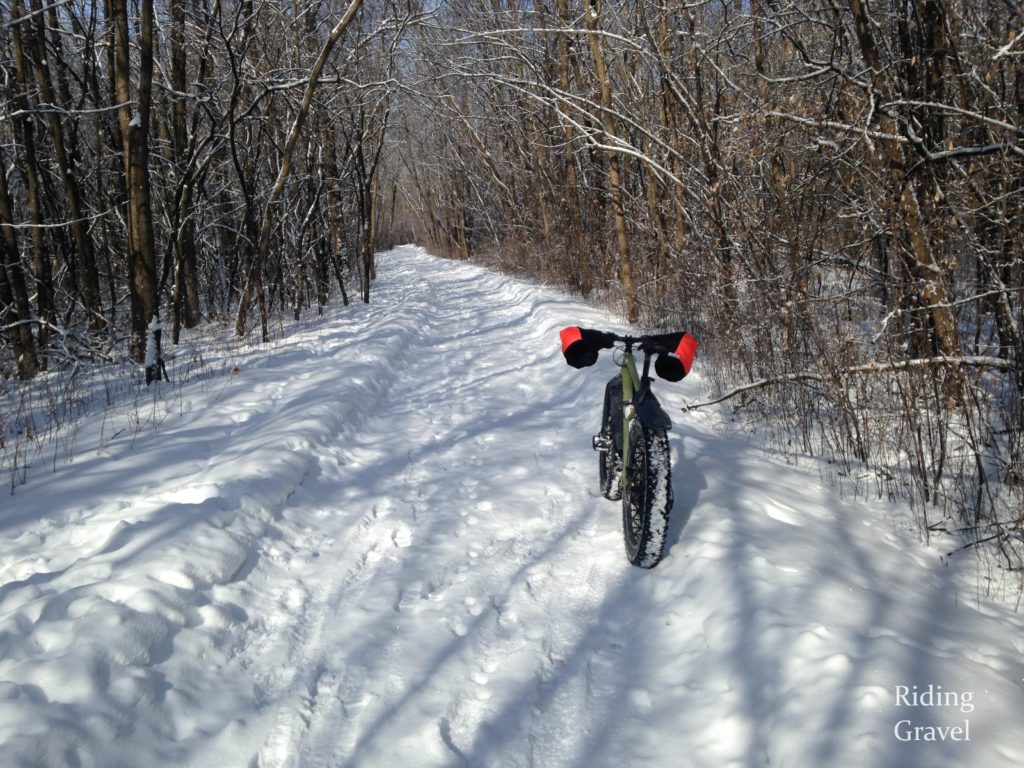
Over the winter my friend Trenton Raygor and I planned a ride to Cosmos on April 14 via the Luce Line, using gravel roads, the Dakota Trail and the Lake Minnetonka LRT for the return. But as the day approached the mother of all spring snowstorms was bearing down on us, so we postponed the ride to May 5. With or without the storm, the ride was not going to happen on the 14th. My 72-mile recon ride on April 11 found the Luce Line impassable except for fat tires and the Dakota Trail treacherous with patches of snow and ice. An 82-mile recon ride a week after the blizzard found the Luce Line still deep in snow.
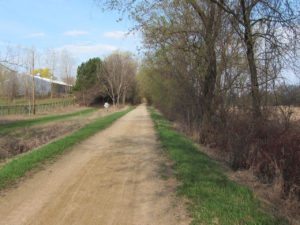
Unfortunately, Trans Iowa left Trenton with an injured ankle, so at 7 am on the 5th, I headed out on my own. It was a chilly clear morning, with an assisting easterly breeze and expectation that that the wind would turn around and help push me home in the afternoon. The Luce Line in the east was still closed for utility work, so from Meadow Park near our house I took West McGinty Road to Wayzata and the Dakota Trail. At Mound I turned north on County 110 to Game Farm Road, a beautiful country road with rolling hills and sweeping turns that took me to a left onto the Luce Line.
I had been making good time but soon realized that it was going to be a long day. The Luce Line is slower further west but now it was even slower thanks to the still soggy crushed limestone, frost heaving, and ruts created by cyclists plowing through spring mud. The real killer, though, was the 10 miles of grass into Cosmos. It reduced me to 5 to 6 mph. At about four miles from Cosmos I could see its iconic water tower, but it took forever to close the remaining distance. Those twenty miles into and out of Cosmos were as hard as anything I have done on a bicycle, and that includes the Heck’s logging roads and muddy ATV trails, the hills of Almanzo in cold high wind, and last year’s Dirty Benjamin blast furnace.
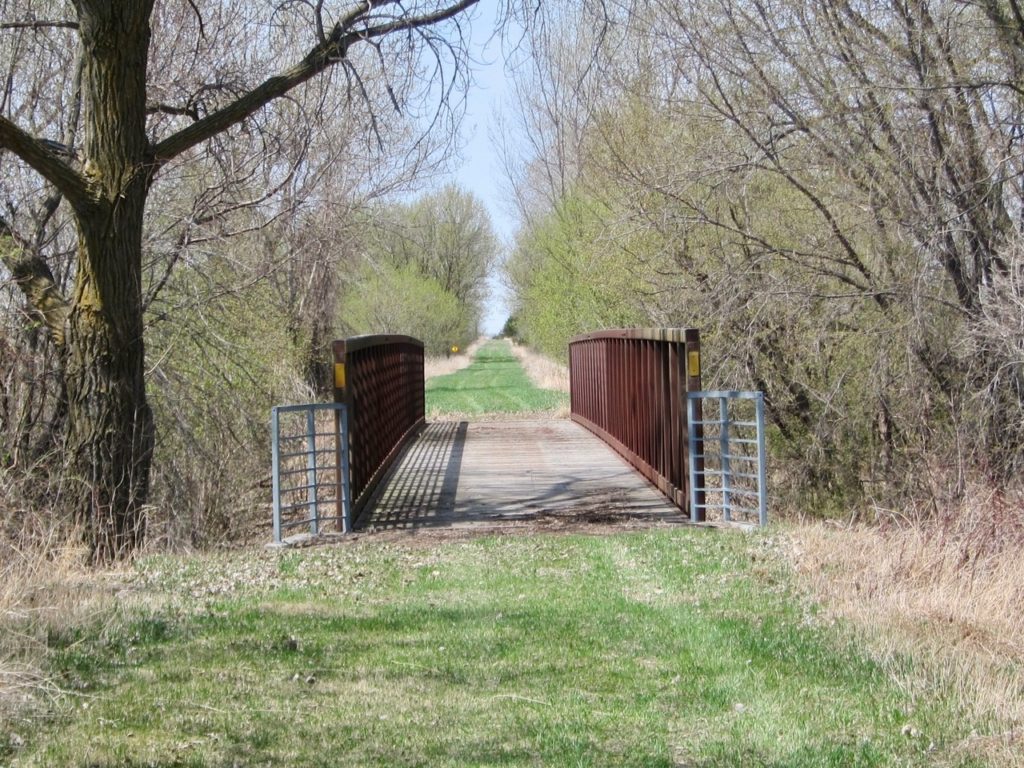
Highway 7 runs parallel to those ten miles, so it would have been easy to ditch the Luce Line for a fast run into Cosmos. But the plan was to take the Luce Line to its end, and besides, riding gravel is all about suffering. If you are riding gravel you have developed an ability to handle pain, but consider yourself warned. 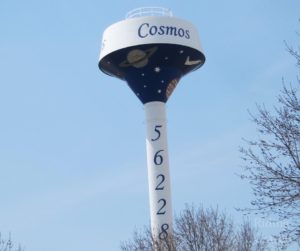 If you want to try the ride to Cosmos, you might want to prepare by sleeping on a bed of nails or you might tack a long green ribbon to a wall and stare at it for hours, inch by inch, while doing a thousand weighted squats.
If you want to try the ride to Cosmos, you might want to prepare by sleeping on a bed of nails or you might tack a long green ribbon to a wall and stare at it for hours, inch by inch, while doing a thousand weighted squats.
The Luce Line emptied out on the lawn at the foot of the water tower. I snapped a picture and, after buying water at Casey’s, found the trail to the town park on Thompson Lake, the site of Daniel Hoyt’s homestead and now the end of the Luce Line. It would have been pleasant to linger in the park, but with the clock ticking, I turned around and headed home.
As I approached Hutchinson, I noticed dark clouds behind me. I wasn’t worried at first, but then RUMBLE, RUMBLE, RUMBLE. I don’t like lightning. Many years ago I lost a close friend to lightning, and I have had two close calls in the high mountains. With real or imagined monsters at my back, I cranked it up a notch or two and got to Hardees before the worst of it. I ordered a Frisco Burger, curly fries, and large diet cola. It was not exactly real food, but better than maltodextrin gel, dehydrated bananas, and energy bars. My legs were hurting so much I could barely sit still to eat.
As the storm passed, I remounted the bike. The ride had been tougher than expected. After a late-arriving spring, trees were only starting to leaf out, so the route had been less picturesque than it would become in another week. And it had been a hot, muggy afternoon.
Now the air was cooler, fresher, and had the sweet scents of ozone and petrichor. The land glistened and colors seemed brighter and iridescent. The massive, spectacular wall of dark clouds and lightning flashes was moving rapidly away to the southeast. Far ahead, a rainbow appeared and disappeared. The evening light and gathering darkness were part of the enchantment. It was perfect, pain included, and I was into it. A door had opened. I was where I wanted to be.
Feeling rejuvenated, I pushed on the paved LL to Winsted. With 40 miles to go, mushy fresh gravel slowed me down as I headed south on Cable to Lester Prairie, but then the speed picked up again on the Dakota Trail and the LRT. With 30 miles to go, the temperature was falling. I put on my rain jacket. After 151 miles I pulled into the driveway at 10:30 pm and turned off the lights and the Wahoo.
PRESENCE, FLOW, AND THE OPEN ROAD
Studies show that strenuous exercise promotes happiness and lowers risk for depression. Getting into the countryside amplifies these effects. Just being in nature supports physical and emotional well-being—so much so that a mere picture of trees in an office reduces stress and improves mood.
Endurance exercise can trigger the “runner’s high.” Along with meditation and other sports and practices, it can also trigger something more intense. Now and then the high can deepen into joy beyond understanding and a strong sense of connection with the earth and even the entire cosmos. In 1901, Richard Burke, a Canadian psychiatrist, described such experiences as “cosmic consciousness.” After considering his own mystical experience along with fifty other cases, Bucke described cosmic consciousness as comprising extraordinary joy and happiness, a deep intuition about the “meaning and drift” of the universe,” “moral elevation,” confidence in immortality or at least greatly diminished fear of death, and a feeling of being bathed in white or pink light. The Buddha and Jesus were two of his examples. Others included the transcendentalists Henry David Thoreau and Walt Whitman.
I like how the phrase “cosmic consciousness” resonates with getting to Cosmos, but I think “awakening,” “enlightenment,” or “mystical experience” better capture the nature of the experience. I also prefer Alan Watts’s characterization:
“To the individual thus enlightened it appears as a vivid and overwhelming certainty that the universe, precisely as it is at this very moment, as a whole and in every one of its parts, is so completely right as to need no explanation or justification beyond what it simply is.”
And he adds that, “The central core of the experience seems to be the conviction or insight, that the immediate now, whatever its nature, is the goal and fulfillment of all living.” Watts, I think, puts his finger on the key elements in the whole range of mystical experiences from small doses or mere glimpses of awakening, as in “the runner’s high,” to the large doses of the sort described in Bucke’s case studies.
Both the “runner’s high” and enlightenment experiences are related to what the psychologist Mihaly Csikszentmihalyi (pronounced Chick-sent-me-high) called “flow.” Indeed, one researcher says that he and most of his colleagues believe flow is a necessary condition for mystical experiences. When Csikszentmihalyi and his research team, and eventually colleagues in many countries, asked thousands of people to describe moments when they were unusually happy, they often described states of total absorption in which everything happened easily and fluidly, like water flowing downstream. In his The Rise of Superman, Steven Kolter contends that flow states account for why adventure athletes in recent years have been completing projects once deemed impossible.
In fact, flow is especially likely in situations involving skill and challenge, particularly where risk requires intense focus and hard effort. Thus, endurance and adventure athletes are prone to entering into flow states. In 1969, the Yosemite/High Sierra climber Doug Robinson observed in “Climber as Visionary” that risk, intense focus, and effort regularly promoted visionary and ecstatic consciousness in mountaineers and big wall rock climbers. In The Alchemy of Action (2013), he offered further examples of visionary experience in climbing and adventure sports and drew on flow research and neurobiology to deepen his insights.
The studies reviewed by Robinson and Kolter implicate dopamine, norepinephrine, and serotonin in flow. Dopamine underpins reward seeking. Norepinephrine supports attention, while serotonin dampens fear. All three neurochemicals elevate mood in different sorts of ways. It was speculated that endorphins in particular account for the runner’s high without much evidence but in 2008 a team of German researchers showed that in fact endogenous endorphins in the brain increase with endurance exercise and probably account in part for positive mood during exercise. Anandamide, an endogenous cannabinoid, is also active in flow. Along with promoting positive mood, it dampens fear. Robinson speculated that endogenous DMT (the so-called “spirit molecule”) might play a role in psychedelic versions of flow or visionary experience. Some research finds that oxytocin, the neurochemical that underlies love, also increases during endurance exercise. The notion that adventure athletes are adrenalin junkies, however, is an oversimplification. Fear can help trigger flow, but adrenalin alone cannot account for all the features of flow, much less for how flow can turn into mystical experiences. Actually, once flow is underway, fear can undermine it.
Meditation, flow, and mystical states are associated with the Task-Positive Network (TPN), one of two major neural activation systems. The other system is the Default Mode Network (DMN). The DMN depends on the medial prefrontal cortex and other structures along the midline of the brain and has strong connections with the amygdala, an area in the emotional brain responsible for fear and anxiety. The DMN fires up during inactivity and when the mind is wandering. Wandering thoughts are often about the self with worries about the future and regrets about the past. One study linked wandering minds with unhappiness. Generally speaking, the two systems are antagonistic—when one is on the other is off and vice versa.
The TPN in contrast depends on lateral regions of the right and left hemispheres of the brain and ramps up when we are absorbed in a project. The TPN energized mind is more interested in the world than the self. In contrast to the DMN, the TPN is trusting, focused, and curious. It also has more tolerance for pain.
The point here is not to disparage the Default Mode. It depends on the most advanced parts of the human brain and is absolutely crucial for characteristics and capabilities that make us human, including self-consciousness, forethought, hindsight, and creativity. But when it is overactive we become anxious, depressed, and miserable. Mental health depends on psychic balance. We restore balance and regain happiness, courage, and sanity when we engage in activities that activate the Task-Positive Network.
When that activation takes us to even a mere whiff of awakening we also rekindle our capacities for awe and wonder. Bucke’s claim about increased intellectual understanding and moral elevation, however, should be taken with a grain of salt. By themselves, flow and mystical experiences simply teach that happiness lies in moving beyond self-preoccupation into openness to the world and awareness that we are more connected with creation than we might have thought.
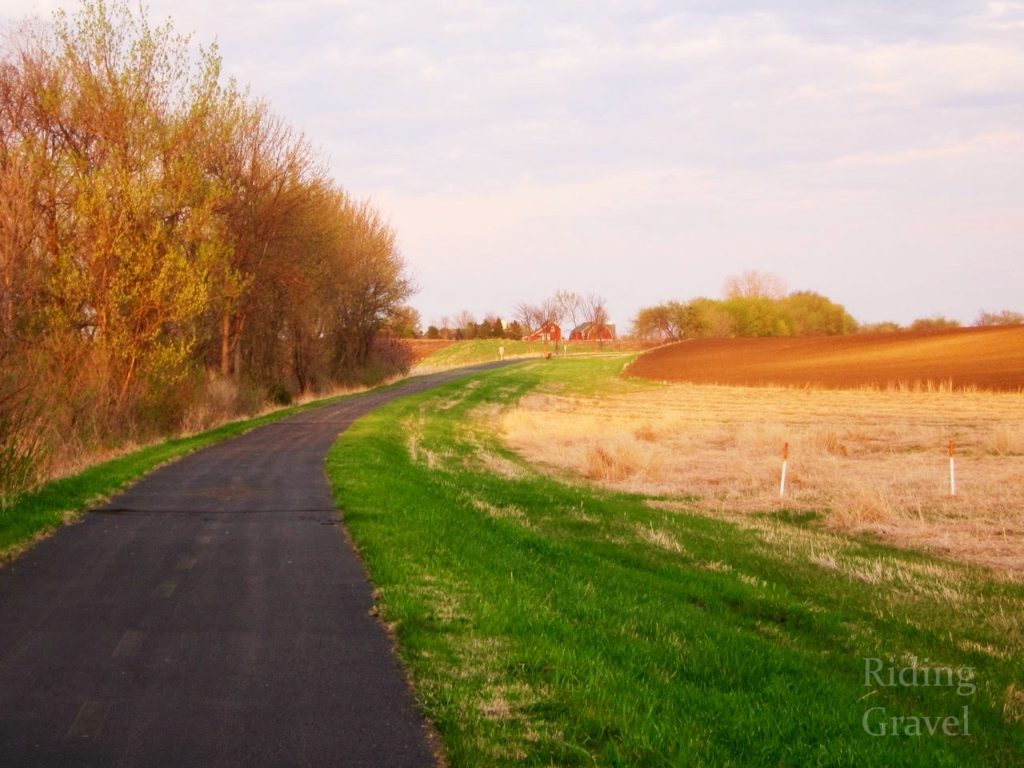
Bucke also believed that cosmic consciousness was a “higher” mental state that was becoming more common and more developed with the advance of civilization. This is also dubious. Bucke bought into the pseudo-evolutionist racist thinking about traditional non-European peoples and cultures that was all-to-common in the 19th century and early part of the 20th century. Actually, unusual happiness, ecstasy, and visionary experiences have occurred throughout history and in many cultures. Neurobiology and physical anthropology are the real clinchers. They strongly imply that capacities for flow and awakening have been part of human nature for a very long time. The skeletal structure of hominid fossils and modern humans and the extraordinary human capacity for thermoregulation tell us that early humans were long-distance runners who practiced “persistence hunting,” or running game animals to ground in the heat of the African sun. Game animals would have been able to out sprint early humans over short distances, but with much less thermoregulation, they would have collapsed from exhaustion and heat stroke when pursued for hours or days. Noting the improved athletic performance, pain tolerance, and increased awareness of the environment in flow, some anthropologists theorize that flow was part of this adaptation. In effect, “the runner’s high” was probably common experience among early humans and a reason why they were so successful. Courage and trust were doubtlessly part of this adaptation. Accidents were possible when running, hunting, and gathering, and big cats, giant raptors, and monstrous snakes were ever-present dangers for males, females, and children.
We revive this primordial, task-positive mindset during long gravel rides. Once committed to our adventures, and facing challenge and risk, we attend to the present moment and the world around us. And with self-centered rumination sidelined, pain and suffering become tolerable, while happiness and curiosity increase along with appreciation of our companions and the natural environment. So we ride well and in good spirits. In his essay on cosmic consciousness quoted above, Alan Watts characterized such movement away from self-concern and into the world as “the equivalent of faith, of committing oneself to the uncontrolled and unknown.” He then concluded, “And there is a very slight distinction, if any, between complete, conscious faith and love.” In the words of the Velominati, “To ride well requires a quiet mind, but the ride itself is the path to enlightenment.”
Suggested Readings
Barrett, Frederick S. and Roland R. Griffiths. “Classic Hallucinogens and Mystical Experiences: Phenomenology and Neural Correlates.” In Behavioral Neurobiology of Psychedelic Drugs, A. L. Halberstadt, F. X. Vollenweider, and D. E. Nichols, eds., pp. 393-340 (Springer, 2018).
Brady, Patrick. Flow State: The Science of Wheeeee! Bicycling, June 2, 1916.
Bucke, Richard Maurice. Cosmic Consciousness: A Study in the Evolution of
the Human Mind (Martino Publishing, 2010).
Csikszentmihalyi, Mihaly. Flow: The Psychology of Optimal Experience (Harper Perennial, 1990).
Harris, Sam. Waking Up: A Guide to Spirituality without Religion (Simon & Schuster Paperbacks, 2014). On the neuropsychology of awakening.
Kolter, Steven. The Rise of Superman: Decoding the Science of Ultimate Human
Performance (New Harvest/Houghton Mifflin Harcourt, 2014).
Mackinnon, Mathew. “Neuroscience of Mindfulness: Default Mode Network, Meditation, and Mindfulness.” Meditation, MD. June 17, 2017.
Peakin Two Years, “Zen and Getting Your Ass Beat,” Velominati: Keepers of the Cog, Jan 31, 2015
Robinson, Doug. “The Climber as Visionary.” Ascent, 1969; The Alchemy of Action (Moving Over Stone, 2013).
Storm, Hyemeyohsts. “Jumping Mouse.” In Seven Arrows, pp. 68-85 (Ballantine Books, 1972). A Plains Indian allegory about leaving the security of home and moving into the open and dangerous prairie with courage, generosity, and curiosity, reaching, finally, enlightenment.
Thoreau, Henry David. Walking (Cricket House Books, 2010).
Velominati. The Rules: The Way of the Cycling Disciple (W. W. Norton & Company, 2014).
Watts, Alan. This is IT and Other Essays on Zen and Spiritual Experience (Vintage Books, 1973).
Whitman, Walt. Selected Poems (Dover Thrift Editions, 1991).
Note
1 Amy Peterson, The History of Cosmos. Typewritten, 1976.
I am grateful to Beth Cronk, Cosmos Librarian, for her assistance. I also want to thank Mary Grove for her edits and her sister Diana Grove for her good thoughts about mindfulness and meditation.
 About The Author: John Ingham is Professor Emeritus of Anthropology at the University of Minnesota. He rode a hybrid bike on trails for years. When he retired in 2011, he renewed his earlier passions for rock climbing, mountaineering, and back packing and began doing longer rides. He has been gravel racing for three years and has completed various races, including the Heck of the North, the Almanzo 100, and the Dirty Lemming 100. Now 77, he appears to be the oldest rider in Minnesota completing major gravel races.
About The Author: John Ingham is Professor Emeritus of Anthropology at the University of Minnesota. He rode a hybrid bike on trails for years. When he retired in 2011, he renewed his earlier passions for rock climbing, mountaineering, and back packing and began doing longer rides. He has been gravel racing for three years and has completed various races, including the Heck of the North, the Almanzo 100, and the Dirty Lemming 100. Now 77, he appears to be the oldest rider in Minnesota completing major gravel races.


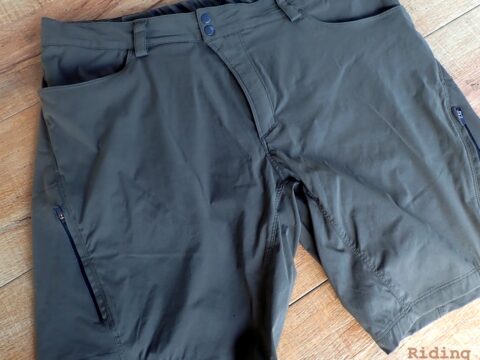





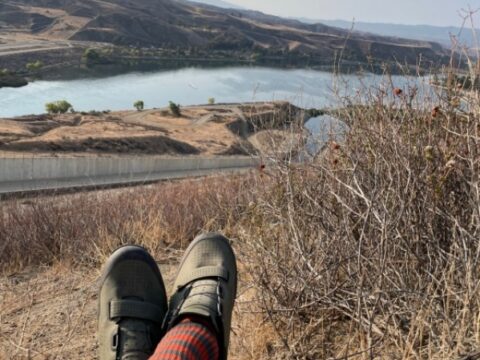
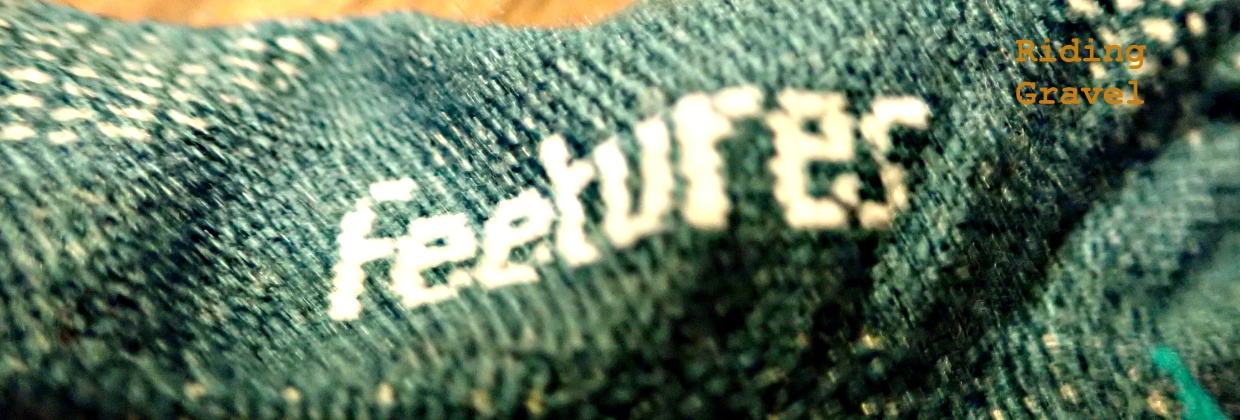

This is the first I’ve heard of someone not giving up when they got to the grass after Hutchinson. For me, the farthest I’ve made it was Winstead and back to NE Minneapolis.